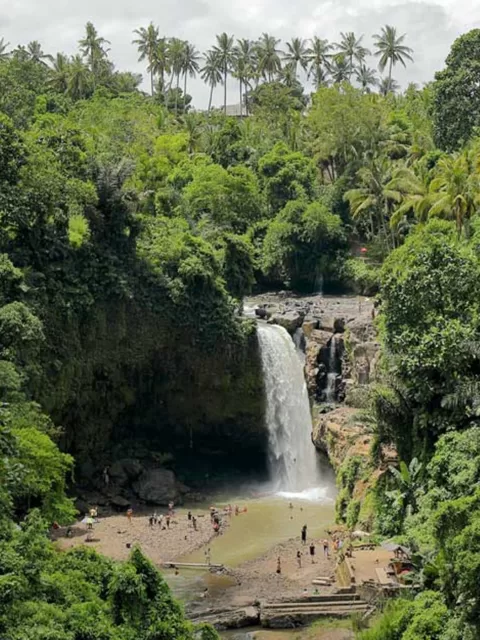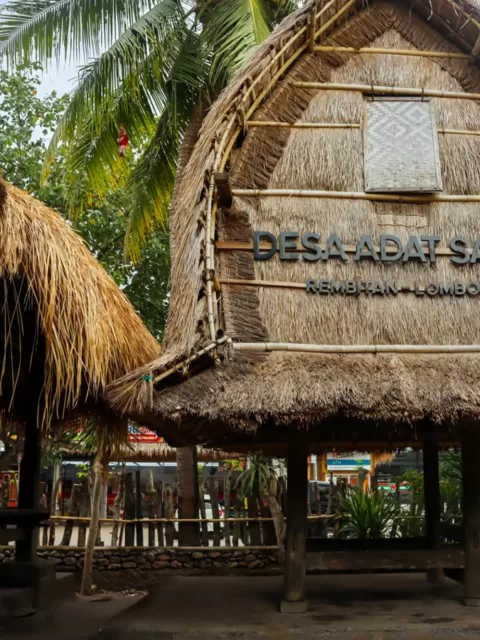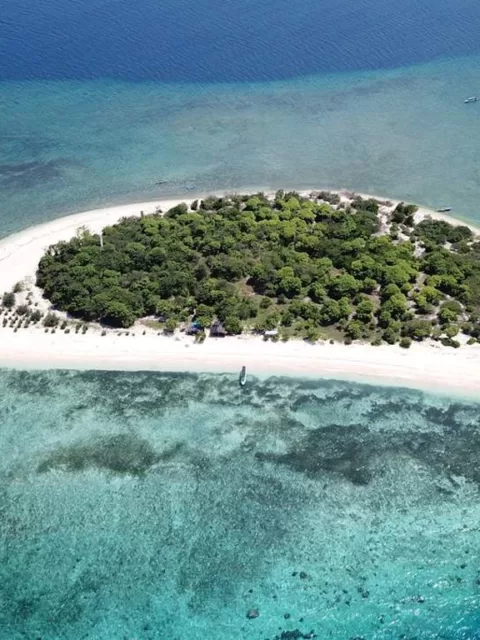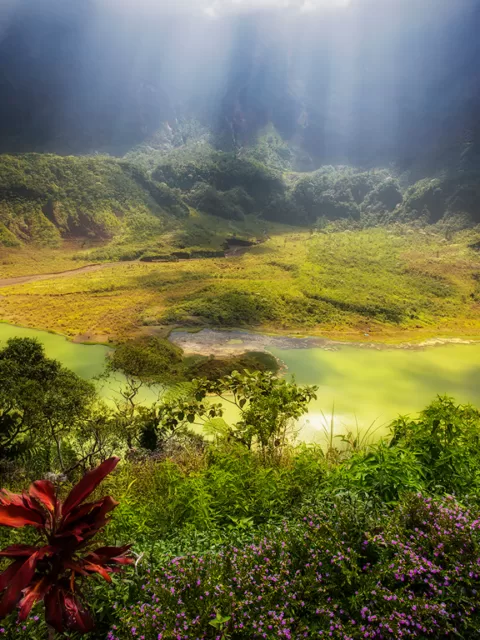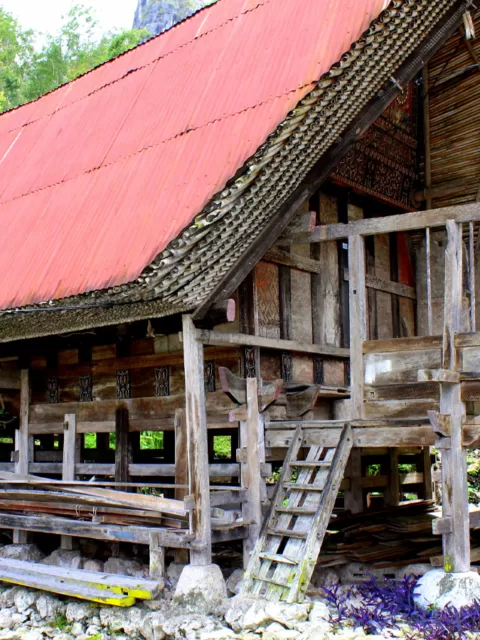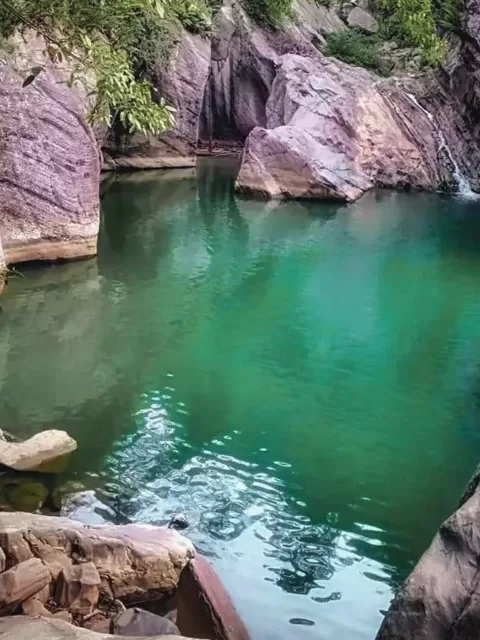Brahu Temple: A Majestic Relic of the Majapahit Dynasty
Rising from the verdant plains of Trowulan in East Java, Indonesia, stands the Brahu Temple, a testament to the architectural brilliance and enduring legacy of the Majapahit Dynasty. This remarkable Hindu temple, constructed in the 14th century, offers a captivating glimpse into the artistic expression and religious practices of this once-powerful empire. Its towering red brick structure, intricate carvings, and spiritual aura promise an unforgettable experience for history buffs and culture seekers alike.
A Glimpse into the Golden Age of Majapahit
The Majapahit Dynasty, established in 1293, rose to become a dominant force in Southeast Asia. Under the reign of powerful monarchs like Hayam Wuruk and Gajah Mada, the empire’s influence stretched from the Malay Peninsula to Sumatra, Borneo, and parts of mainland Southeast Asia. During this golden age, art, literature, and architecture flourished, leaving behind a wealth of cultural treasures. Among these treasures stands the Brahu Temple, a masterpiece of design and a silent witness to the dynasty’s remarkable achievements.

The Brahu Temple: A Symbol of Power and Spirituality
Built of red bricks, the Brahu Temple stands tall and proud, facing west towards the setting sun. Its rectangular base, measuring 18 by 22.5 meters, is topped by a three-tiered roof that once reached an impressive height of 20 meters. Though time has eroded its grandeur, the temple’s imposing structure still evokes a sense of awe and wonder.
The temple’s facade is adorned with intricate carvings depicting scenes from Hindu mythology and showcasing the skilled craftsmanship of Majapahit artisans. Delicately carved figures of deities, mythical creatures, and floral motifs adorn the walls, offering a glimpse into the artistic sensibilities and beliefs of the era.
Beyond its aesthetic beauty, the Brahu Temple held immense religious significance. It served as a central place of worship for the Hindu community of Trowulan, hosting daily rituals, grand ceremonies, and religious festivals. Inside the temple, one can find remnants of a central garbhagriha, the innermost sanctum where sacred images were once housed. Inscriptions found near the temple suggest it may have been dedicated to Vishnu, the Hindu god of preservation.
Exploring the Legacy of Majapahit
Today, the Brahu Temple stands as a vibrant reminder of the Majapahit Dynasty and its enduring legacy. The temple complex is open to visitors, offering a unique opportunity to immerse oneself in the history and culture of this ancient civilization. Guided tours are available, providing detailed explanations of the temple’s architecture, symbolism, and religious significance.
For those seeking a deeper understanding of the Majapahit era, numerous resources are available. The Trowulan Museum houses a collection of artifacts and exhibits dedicated to the dynasty’s history and achievements. Additionally, historical texts like the “Nagarakretagama” and the “Pararaton” offer insights into the social, political, and cultural landscape of Majapahit.
A Journey Through Time and Culture
Visiting the Brahu Temple is more than just a sightseeing excursion; it’s an opportunity to travel back in time and experience the magic of the Majapahit Dynasty firsthand. From its awe-inspiring architecture and intricate carvings to its religious significance and historical context, the temple offers a multifaceted experience that will resonate with history buffs and culture enthusiasts alike.
Exploring the Grounds of Brahu Temple
As visitors approach this temple, they are greeted by expansive courtyards that once hosted vibrant ceremonies and cultural events. The temple complex is laid out in a manner that reflects the Majapahit penchant for symmetry and order. Stone pathways lead to the central structure, offering glimpses of the surrounding lush greenery that adds to the temple’s serene ambiance.
Within the Brahu Temple complex, several structures stand as silent witnesses to the dynasty’s historical grandeur. Notable among these is the main temple, dedicated to a triad of deities – Shiva, Vishnu, and Brahma. The intricately adorned gates and smaller shrines within the complex contribute to the holistic experience of exploring Brahu Temple’s sacred grounds.
Beyond its architectural marvels, Brahu Temple is framed by the natural beauty of the Indonesian landscape. Towering trees and indigenous flora surround the temple, creating a serene backdrop that enhances the visitor’s experience. Exploring Brahu Temple isn’t merely a historical journey; it’s an immersion into a harmonious blend of human craftsmanship and nature’s bounty.
Cultural Significance of Brahu Temple
Brahu Temple served as a sacred space for religious practices and ceremonies during the Majapahit Dynasty. The triad of deities worshipped at the temple reflects the religious syncretism of the time, where Hinduism and Buddhism coexisted and influenced each other. Visitors can envision the vibrant rituals and spiritual gatherings that once animated the temple’s courtyards.
Delving into the historical worship practices at this temple provides insights into the spiritual fervor that defined the Majapahit Dynasty. The temple likely witnessed elaborate ceremonies, including offerings, prayers, and performances, as the Majapahit people sought divine favor and celebrated their cultural identity. Exploring Brahu Temple allows modern visitors to connect with the ancient rhythms of devotion that once echoed through its hallowed halls.
While this temple stands as a historical artifact, its cultural and religious significance persists to this day. Local communities surrounding the temple may engage in rituals and ceremonies that pay homage to the Majapahit legacy. Understanding the contemporary cultural context adds layers to the visitor’s experience, emphasizing the enduring impact of the Majapahit Dynasty on the region.

Preservation Efforts and Conservation Initiatives
Preserving a cultural relic as ancient as Brahu Temple comes with its share of challenges. Over the centuries, the temple has faced threats from natural elements, unauthorized excavations, and the passage of time. Understanding the historical conservation challenges provides context for appreciating the ongoing efforts to safeguard this architectural gem.
Contemporary conservation initiatives have been instrumental in ensuring the longevity of Brahu Temple. Collaborative efforts involving archaeological experts, government agencies, and local communities aim to protect the temple from environmental degradation and human-induced threats. Preservation methods, such as structural reinforcements and controlled tourism, strike a delicate balance between accessibility and conservation.
Visitor Experience at Brahu Temple
For visitors eager to unlock the mysteries of this temple, guided tours offer a curated exploration led by experts. Experienced guides provide historical context, share anecdotes, and highlight architectural details that might go unnoticed by the untrained eye. Interpretive programs enhance the visitor’s understanding of Brahu Temple’s role in the Majapahit Dynasty.
Brahu Temple isn’t merely a physical site but an educational resource for those curious about Indonesian history. Educational programs, including on-site exhibits and multimedia presentations, offer a comprehensive look at the Majapahit Dynasty’s cultural and political landscape. Visitors can immerse themselves in the rich narrative that unfolds within the temple’s walls.
To enhance the tourist experience, Brahu Temple offers engaging activities that transport visitors back in time. Interactive exhibits, reenactments of historical ceremonies, and workshops on traditional Majapahit crafts allow tourists to actively participate in the living history of the temple. Such immersive experiences create lasting memories and foster a deeper appreciation for the cultural heritage enshrined in this temple.
Practical Tips for Exploring Brahu Temple
Situated in proximity to modern urban centers, Brahu Temple is accessible by various modes of transportation. Visitors can choose from guided tours, private transportation, or even opt for eco-friendly alternatives like cycling to the site. Understanding the transportation options ensures a seamless journey to and from Brahu Temple.
Timing plays a crucial role in optimizing the Brahu Temple experience. Avoiding peak tourist seasons allows for a more tranquil exploration of the site. Additionally, considering weather conditions and any ongoing conservation activities ensures that visitors can appreciate the temple’s beauty while respecting its delicate surroundings.

Surrounding Attractions and Points of Interest
A visit to Brahu Temple can be part of a broader exploration of the Majapahit Dynasty’s legacy. Nearby historical sites and temples, such as Candi Singosari and Candi Jawi, complement the Brahu Temple experience. Creating a comprehensive historical itinerary provides a holistic understanding of the cultural landscape shaped by the Majapahit Dynasty.
Beyond the archaeological wonders, engaging with local communities adds depth to the Brahu Temple visit. Interacting with residents, participating in cultural events, and supporting local businesses contribute to sustainable tourism. These interactions provide valuable insights into the contemporary significance of Brahu Temple in the lives of those who call its surroundings home.
Preserving Brahu Temple’s Legacy
Preserving Brahu Temple’s legacy requires ongoing conservation efforts that address both immediate and long-term challenges. Regular maintenance, periodic assessments, and technological interventions contribute to the sustainable preservation of this cultural relic. The involvement of conservation experts ensures that Brahu Temple continues to inspire awe for generations to come.
While efforts are underway to protect Brahu Temple, heritage preservation is not without its challenges. Factors such as climate change, urban development, and inadequate funding pose threats to the temple’s integrity. Acknowledging these challenges is essential for devising robust strategies that safeguard Brahu Temple against potential risks.
Awareness and Advocacy for Brahu Temple
Creating awareness about this temple’s historical and cultural significance is paramount for its continued preservation. Educational programs, both on-site and online, play a crucial role in disseminating knowledge about the Majapahit Dynasty and the importance of Brahu Temple in the historical narrative. Outreach efforts target diverse audiences, from students to international tourists.
Advocacy for Brahu Temple involves positioning it as a must-visit heritage destination. Collaborations with travel agencies, inclusion in cultural heritage tours, and active promotion on digital platforms contribute to the temple’s visibility. By positioning Brahu Temple as a cultural gem, there is a greater likelihood of garnering public support for its conservation.
Final Thoughts
In retrospect, Brahu Temple stands as a testament to the cultural and architectural achievements of the Majapahit Dynasty. Its intricate design, historical resonance, and cultural richness make it a jewel in Indonesia’s heritage crown. Brahu Temple’s majestic significance extends beyond its physical structure, encapsulating the spirit of an empire that once reigned supreme in Southeast Asia.
The journey into Brahu Temple is an invitation to appreciate the intersection of history, culture, and spirituality. As travelers explore its courtyards, marvel at its carvings, and absorb the serenity of its surroundings, they become part of a narrative that spans centuries. Brahu Temple, with its majestic allure, beckons to those seeking not just a tourist destination but an immersive encounter with the living legacy of the Majapahit Dynasty.
Review: Brahu Temple - Timeless Majesty
The Brahu Temple is an absolute must-visit for anyone interested in history, architecture, or Southeast Asian culture. Its impressive structure and rich history provide a truly unforgettable experience. Visitors can easily spend hours exploring the temple complex and appreciating its beauty and significance. While some areas of the temple are in ruins, it does not detract from the overall experience. The information provided by guides and the readily available resources help visitors gain a deeper understanding of the Majapahit Dynasty and the temple's role within it. Overall, the Brahu Temple is a fascinating and educational site that offers a unique window into the past. Its historical significance, architectural beauty, and accessibility make it a valuable destination for any traveler.
Pros
- Immense historical significance as a relic of the Majapahit Dynasty
- Stunning architecture with intricate carvings and red brick structure
- Offers a unique opportunity to learn about Majapahit culture and religion
- Well-preserved and accessible to visitors
- Located near other historical sites in Trowulan
Cons
- Limited information available in English
- Some parts of the temple are in ruins
- Can be crowded during peak season
- Requires transportation to reach from Mojokerto





